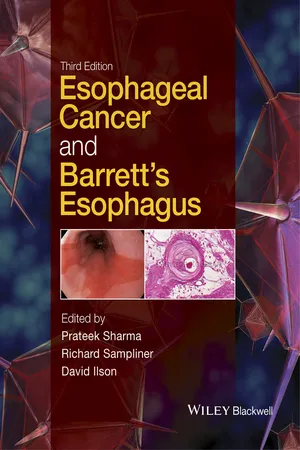
Esophageal Cancer and Barrett's Esophagus
- English
- ePUB (mobile friendly)
- Available on iOS & Android
Esophageal Cancer and Barrett's Esophagus
About this book
Esophageal Cancer and Barrett's Esophagus, 3E, focuses on these two common and key conditions that affect the esophagus, providing expert guidance to their pathogenesis, cause, prevention, diagnosis and clinical management.
Top international names in the field examine each of the many issues involved, using the very latest evidence-based research, and clear, didactic advice allows the reader to understand the best methods of diagnosis and clinical management of each condition – whether early or late stage.
Well-illustrated and fully revised to include the latest in ACG/ASG/UEGW guidelines, it is the perfect consultation tool for gastroenterologists and oncologists managing patients with cancer of the esophagus. It is also ideal for teaching residents and fellows optimum patient management, and for identifying areas requiring future research.
Frequently asked questions
- Essential is ideal for learners and professionals who enjoy exploring a wide range of subjects. Access the Essential Library with 800,000+ trusted titles and best-sellers across business, personal growth, and the humanities. Includes unlimited reading time and Standard Read Aloud voice.
- Complete: Perfect for advanced learners and researchers needing full, unrestricted access. Unlock 1.4M+ books across hundreds of subjects, including academic and specialized titles. The Complete Plan also includes advanced features like Premium Read Aloud and Research Assistant.
Please note we cannot support devices running on iOS 13 and Android 7 or earlier. Learn more about using the app.
Information
Chapter 1
Epidemiology of esophageal carcinoma
1.1 The incidence and mortality related to esophageal cancer


1.2 Mortality
1.2.1 Progression of BE to EA
1.3 Risk factors for EA
| Degree of confidence | Risk factor(s) |
| Definite risk | |
| Increased | BE |
| Obesity | |
| Central obesity | |
| Smoking | |
| GERD | |
| Family history of BE or EA | |
| Decreased | H. pylori |
| Aspirin/NSAIDs | |
| No change | Alcohol |
| Possible risk | |
| Increased | Bisphosphonates |
| Decreased | PPI |
| Statins |
1.3.1 GERD
1.3.2 Tobacco smoking
Table of contents
- Cover
- Title Page
- Copyright
- Table of Contents
- List of contributors
- Preface
- Chapter 1: Epidemiology of esophageal carcinoma
- Chapter 2: Barrett's esophagus: definition and diagnosis
- Chapter 3: Epidemiology and prevalence of Barrett's esophagus
- Chapter 4: Esophageal adenocarcinoma: risk factors
- Chapter 5: Esophageal motility abnormalities in Barrett's esophagus
- Chapter 6: Molecular biology of Barrett's esophagus and esophageal adenocarcinoma
- Chapter 7: Histology of Barrett's esophagus: metaplasia and dysplasia
- Chapter 8: Helicobacter pylori and esophageal neoplasia
- Chapter 9: Screening and surveillance
- Chapter 10: New surface imaging technologies for dysplasia and cancer detection
- Chapter 11: New cellular imaging technologies for dysplasia and cancer detection
- Chapter 12: The role of endoscopic ultrasound in esophageal cancer
- Chapter 13: Staging of esophageal adenocarcinoma by CT, PET, and other modalities
- Chapter 14: Medical management of Barrett's esophagus
- Chapter 15: Thermal therapies and photodynamic therapy for early esophageal neoplasia
- Chapter 16: RFA for early esophageal neoplasia
- Chapter 17: The role of endoscopic cryotherapy for treatment and palliation
- Chapter 18: Endoscopic resection
- Chapter 19: Endoscopic submucosal dissection
- Chapter 20: Surgical therapy of early esophageal cancer
- Chapter 21: Chemoprevention: can we prevent esophageal cancer?
- Chapter 22: Selection of patients for cancer prevention and eradication
- Chapter 23: Combined modality therapy in locally advanced esophageal cancer
- Chapter 24: Surgery in locally advanced esophageal cancer
- Chapter 25: Radiation therapy for locally advanced esophageal cancer
- Chapter 26: Systemic therapy and targeted agents in advanced esophageal cancer
- Chapter 27: Role of endoscopy and nutritional support in advanced esophageal cancer
- Index
- End User License Agreement